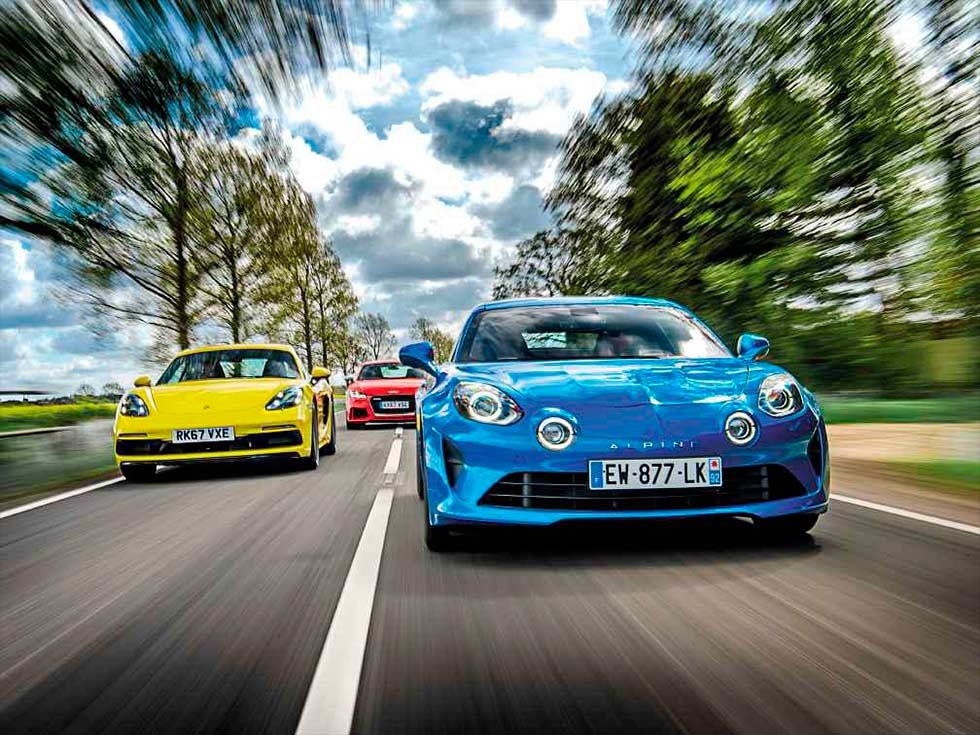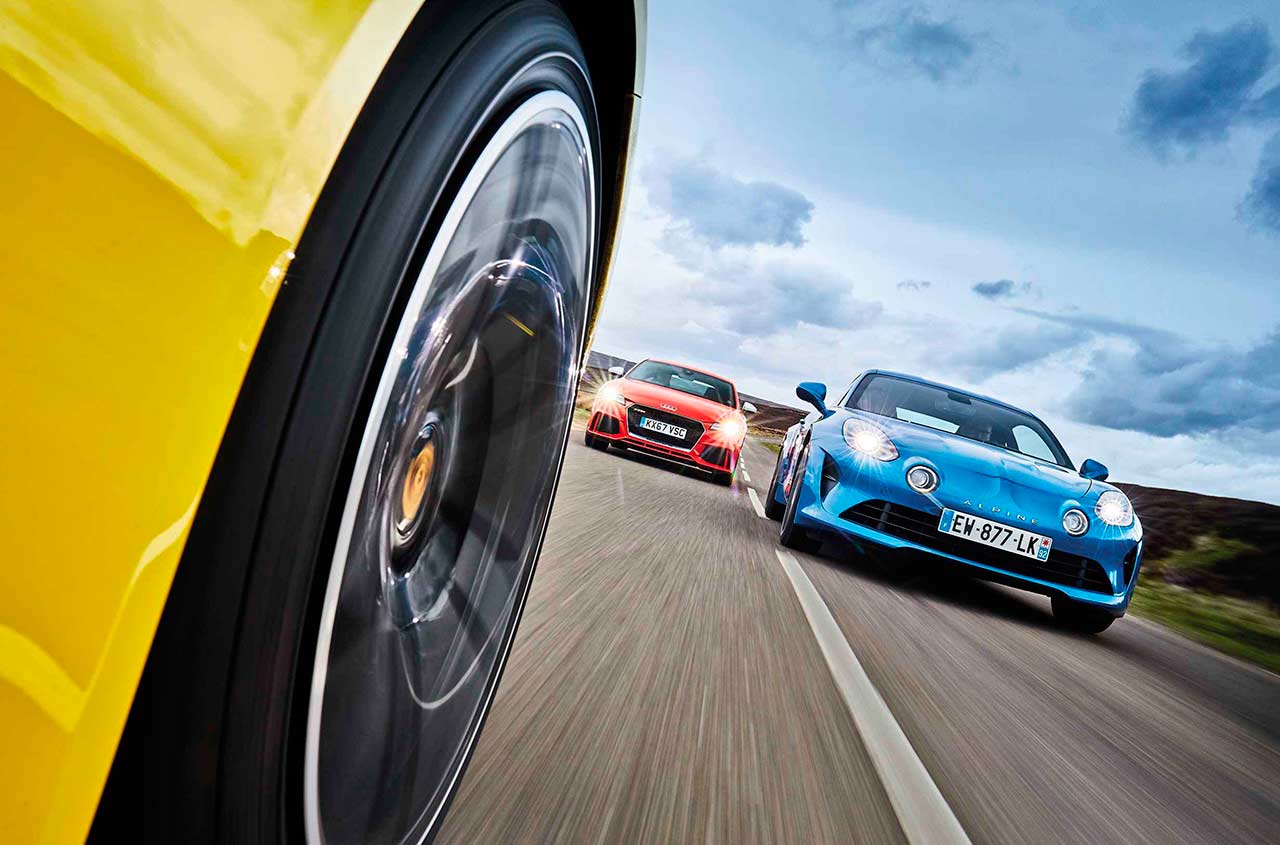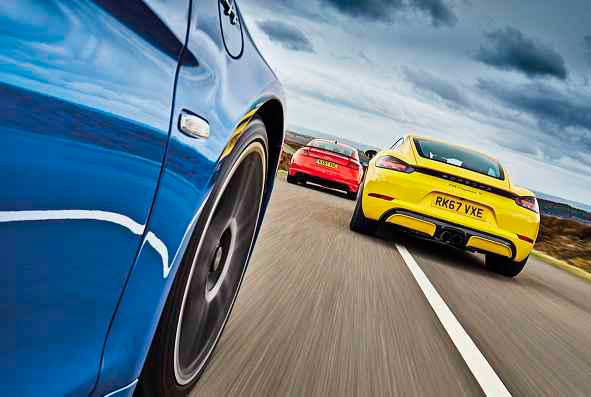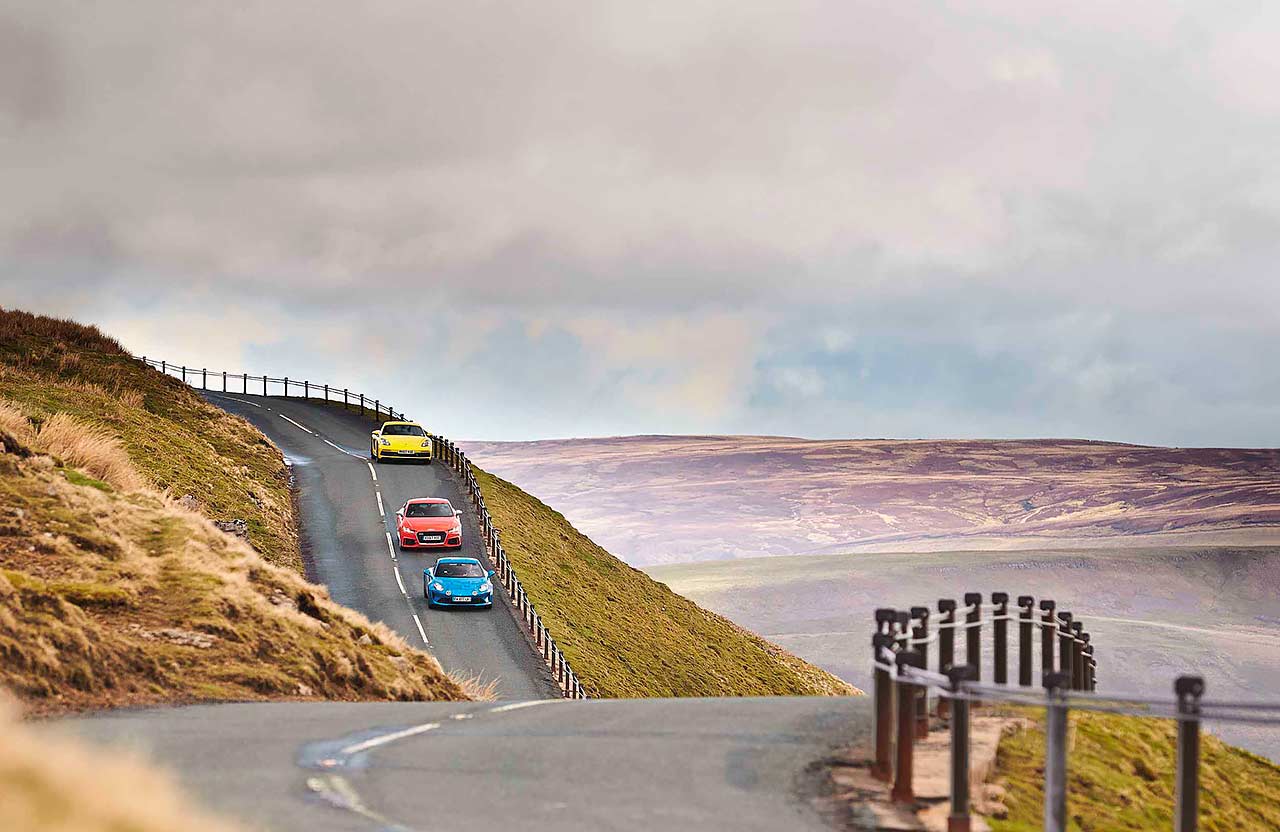
Drive-My Supertest 2019 Alpine A110 versus 2019 Porsche 718 Cayman S 982C and 2019 Audi TT RS 8S. Alpine’s A110 is a breath of fresh air in the German-dominated sports coupe sector. But has the French upstart got what it takes to vanquish the established players? Words by John Barker. Photography by Matt Howell.
Judgement day SUPERTEST: A110 v CAYMAN S 982C v TT RS 8S This is the big one: is Alpine’s new A110 good enough to beat the dynamically brilliant Porsche Cayman S and the blisteringly fast Audi TT RS? Four days and 2000 miles on road, track and against the clock resulted in the slimmest of winning margins we’ve had to date. Ladies and gentlemen, place your bets…
THE DRIVE
The Porsche and the Audi are already parked, side-by-side, waiting for the Alpine to show. In bold colours, sitting on 20-inch wheels, they look solid and well made, confidently hewn. When the A110 arrives and swings in next to them, I’m shocked at how small and low it is. It’s the first time I’ve seen one in the metal and it never occurred to me that one of the reasons it’s so light is that it’s small, with small wheels – 17s as standard, 18s on this, the launch edition.

Feedback from the A110 launch was highly complimentary, with many experienced testers, including our own Steve Sutcliffe, claiming that the Cayman’s dominance was under threat. Well, this is where we find out just how credible the Alpine is. The price of this A110 Première Édition is strong at £51,805 (though all 1955 examples were snapped up in days) and the top-line production version, the ‘Legende’, won’t be far off £50k, so the rivals here to meet it are the Cayman S (base price £51,853) and the TT RS (£52,480).

The A110 was always going to be a hard sell: a new and unproven mid-engined sports coupe powered by a 1.8-litre, four-cylinder turbo engine. Or, for the same money, the Cayman: charismatic, polished and dynamically peerless. So I imagine the management at Alpine couldn’t believe their luck when Porsche announced it would be scrapping the silky, flat-six engines of the Boxster and Cayman and replacing them with turbocharged flat-fours. That’s one objection of the potential Alpine customer scotched.

There’s a lot more to the Cayman than just the engine though, as the three-hour journey to this café in picture-postcard pretty Hutton-le-Hole in the North York Moors has reiterated. The 718 Cayman S looked fabulous on my driveway, better than any previous version, and it swallowed both my luggage and – more impressively – the gear of photographer Matt Howell. It rides beautifully, too, supple yet controlled, and show it any sort of corner and it will show you some flair, with incisive but calm steering and natural balance and agility – it seems to rotate around a point between the seats. Boy, it’s good.
‘It sounds awful,’ says Howell. ‘When you started it up I didn’t realise it was a four, but now…’ I have to agree. I had hoped it would be better, this being a heavily revised version. The original flat-four installation was jaw-droppingly bad with, amongst other aural maladies, a mid-range coarseness that was worse on the overrun and a number of whooshes and sighs that would have been deemed turbo character if they related to the demand being made of the engine, but instead seemed random. Two years on and all that noise has gone or been suppressed, and it is 100 per cent better, but what’s left is a mournful, monotone, mid-range drone.
The tragedy is that in most other respects, there’s never been a better Cayman. There’s no question that the 2.5-litre flat-four delivers the claimed 345bhp, and it works in a superb close harmony with the (optional) seven-speed PDK gearbox, and dynamically the car is as sweet as. So when you’ve just threaded it along a few good miles of choppy Yorkshire B-road and wrung out the engine to the red line – where it sounds at its best – you know that it’s still going to take something special to unseat it.

That something could be the Alpine. With 249bhp it might be 96bhp down on the Cayman, but it’s stayed pretty much the same size in the Porsche’s rear-view mirror, bobbing around in its wake, small, low and blue, and distinctive with its inset driving lamps. It’s time to see what all the fuss is about.
Pound for pound, you get less for your money with the A110, which is a good thing if you are open to the many benefits of less mass. Build light from the start, as Alpine has, investing in aluminium construction (94 per cent of the body and chassis is aluminium) and you set the car on a virtuous circle of weight reduction. Less initial weight means you need less power for the same performance, which means you can use a smaller engine with fewer cylinders, which further reduces weight, allowing smaller brakes and smaller wheels and tyres, which means less unsprung weight, which allows lighter springs and smaller dampers, and so on…
It’s a philosophy championed by Lotus, and it has been obsessively adhered to by the Alpine development team, too, but while Hethel’s modern offerings tend to look chunky and feel spartan, the Alpine looks more like a scaled-down conventional coupe – sleek, with crisp shut lines, and a warm, welcoming cockpit with many of the expected modern trappings. There’s a band of leather across the dash facia, the instruments are provided by a big TFT screen with neat, unique graphics, while beneath the arc of centre console, neatly trimmed in carbonfibre, is a space for phones and other chattels. The high-sided seats make this cubby awkward to get at, though, and beyond the leather and carbon there is quite a lot of hard, scratchy plastic, which is probably stiff and light, but which feels more out of place in a £51k coupe than the body-coloured trim on the door casings.
The seats, with their quilted leather sides and fixed-back lightweight frames, look seriously sporty, but in fact are easy to get into and very comfortable, as well as being supportive. They’re part of the launch edition upgrades, as are the numerous tricolour flashes and carbon trim for the air vents and centre console. Another remarkable thing about the A110 is that although it looks small on the outside, it doesn’t feel like it from the inside.
Hidden behind the insulating cover beneath the wrap-around rear screen is the all-new, all-aluminium turbocharged 1.8-litre in-line four-cylinder engine, mounted in a bespoke aluminium subframe and coupled to an evolution of the Renault Clio’s Getrag dual-clutch gearbox. Thumb the big orange button on the centre console and the noise it makes when it fires up is cleaner and sweeter than the flat-four in the Porsche. Not much of a stretch, admittedly, but there’s a lightness to the way it responds when you blip the throttle, too, and within a couple of miles it has proved to be decently characterful, with a nutty, hollow bark when pulling hard, overlaid with turbo-spooling whoosh. More importantly, it feels properly sparky – well up to the task, though that’s as much to do with the mass of the car.
Those first couple of miles aren’t about the performance, though. What grabs your attention is the way the Alpine feels on the road, how it reacts to steering inputs and bumps and bends. It feels genuinely light, through the electrically assisted steering and its connection to the road, as if the front tyres are even slimmer than their 205/40 R18 dimensions and are offering little resistance. Then there’s the ride, which is loose-limbed and feels long-legged, helping create a unique impression of suppleness and effortlessness. It’s like an original Lotus Elise but not quite, the ride of the Alpine being a little more easily disturbed at the front.
Pick up speed and the steering effort required increases appropriately, giving a workable level of effort, while the feel around centre, previously soft and open, closes to bring welcome precision. Squeeze on the throttle and after a moment’s hesitation (there’s a moment of lag in all three cars) the Alpine surges down the road, a quick and seamless upshift providing unbroken acceleration. And the ride parries some of the bigger bumps and neutralises some of the detail of a road surface that the Cayman proved was oddly tricky and wrong-footing when we drove up. I’m grinning; I like the attitude and approach of this Alpine. It feels modern and classic French at the same time.
The TT RS is looking a bit too familiar, but you’d be wrong to dismiss it, for a few good reasons. The first and most significant is that it’s not a car that will struggle for engine power or character, because installed transversely beneath its mirror-finish gloss red bonnet is an in-line five-cylinder turbo engine cranking out almost 400bhp.
At the weigh-in, our corner-weight scales threw up a couple of surprises. The fact that the TT was the heaviest wasn’t one of them. That at 1487kg it was only 38kg heavier than the Cayman S was… As was the fact that the A110 came in at just 1094kg, under the claimed figure (1103kg) and almost 400kg less than the Audi. That’s not the whole story, of course, because while the Porsche distributes the load with something approaching equity (44:56 front:rear), and the Alpine slightly less so (42:58), the Audi gets nowhere near that. The latest straight-five may have an aluminium cylinder block, helping reduce the engine’s overall mass by a useful 30kg, and it may be installed transversely (as opposed to longitudinally like a battering ram in the Ur-Quattro), but it all still sits forward of the front axle line. As a result, more than 900kg rests on the front axle for a nose-heavy 61:39 distribution.
Mind, there is at least one upside of being front-engined, and that’s that the TT has rear seats. Small ones, granted, but useful for shopping or luggage if you don’t have small children. There’s a half-decent boot, too, so it rivals the Cayman for practicality. The Alpine is merely OK, with a stuffable boot beneath the small bootlid and a rectangular space beneath the bonnet that looks millimetre-perfect for a prêt-à-porter suitcase (‘max load 40kg’). It’s the bling that catches your eye first in the TT: the machineturned centre console plate and door pulls, the five air vents with (optional) coloured bands, and the shiny centre buttons that are the controls for the air conditioning and heated seats. Then there’s the Alcantara-rimmed wheel with its see-through spokes and starter button and Drive Select mode switch hanging off it, all of which helps make for a clean centre console. In contrast, the ‘fireplace’ of the Cayman – that space ahead of the gear selector – looks like a dump for switches and buttons. Braille would probably help find the one you want in the dark. The driving position of the TT is less special than those of the Cayman and A110, though, being high in comparison, like in a hot hatch.
If you’re a fan of the Ur-Quattro, the first press of the starter button is a moment to savour. There’s a pop-crackle flare followed by that distinctive, evocative mellow warble. It simply blows the others away – the Porsche sounds like a muted Impreza crossed with an air-cooled Beetle, while the Alpine sounds like a plain old hot hatch. On the move the TT is a bit less distinct, like you’re being followed by an Ur-Quattro, but just ahead of the gear selector there’s a button to sort that. It engages a physical, exhaust plumbing enhancement rather than sound piped through the audio system, and it adds just the right amount of richness and edge.
The steering needs similar help. The rim is unusually but comfortably shaped, and nicely tactile thanks to the faux suede parts, but the efforts it demands are just a bit too low to inspire confidence when you pick up the pace. A dip into the adaptive setting of the driver modes allows steering weight and other parameters to be adjusted, including damping.
It certainly doesn’t need to be any stiffer on these Dales roads. There’s an underlying tautness to the TT RS that can feel very granular at times, which I’d put money on being down to the 20-inch wheel option on this car.
I’ve got road test editor James Disdale behind in the Alpine, and the TT is so fast and such a straightforward, undemanding car to hustle along it feels like I should be able to shake him, on the straight bits at least. There’s impressive grip and traction – no slip at either end at sane speeds – but the Alpine is always there. And as the road gets more lumpy, the Audi gets less poised. You start to wince dropping into compressions, while over sharp crests the car feels launched… at which point it feels every one of those 393 kilos heavier than the Alpine, and you fear for the 30-section tyres (and the rims) when you land.
It’s been a fun run, illuminating, too. James has a knowing look on his face when we pull up on the cobbles outside of our hotel at the top of the hill in Reeth. ‘The A110 simply goes with the flow, while the Audi jiggles and hops in a way that suggests it’s simply not getting on with the surface,’ he observes.
In isolation, the TT RS would feel indomitable: incisive, with terrific cornering grip and massive punch. It lacks the engagement of the A110 and the Cayman, though, that sense that you’re a part of the process of making the car go quickly, other than steering it accurately and getting on the power at the right time. The Alpine stays in touch because it rolls into the turns carrying more speed and, despite the horsepower deficit, hangs on to the TT’s tailpipes because it’s so much lighter and more responsive. There are a few foibles, though. The sense of connection to the front wheels isn’t as strong as you’d like sometimes, and occasionally a sequence of bumps will set off a lateral bobble, as if the front wheels are shimmying in turn.
‘The TT feels more like a very fast hot hatch than a genuine sports car, though that howling motor sounds part Group B rally car and part R8 V10,’ grins James. On the other hand, the Porsche, we agree, is dynamically sublime. ‘The steering is quick without being nervy, and once the front tyres are biting it delivers by far the most detailed feedback,’ says James. ‘Factor in the beautiful balance, near faultless damping and tenacious grip and the Cayman is both fast and fun. It’s also the only one here that’s really throttle-adjustable.’
Day two of our tour de Yorkshire sees light rain falling out of a clear blue sky. In a reverse of our arrival, James leads away in the Alpine and I’m behind in the Audi. The wetted surface seems to be making him more circumspect and the TT is able to manage the gap, playing with the French coupe like a cat with a mouse. I feel relaxed; the Audi has grip and grunt to spare and does some things very well: its dual-clutch gearbox is slick and intuitive, its selector lever logic-natural and tactile (the Porsche’s feels clunky, the Alpine’s buttons a cop-out), and after you’ve pulled a paddle the ’box holds manual mode for just the right amount of time. Turns out that on the damp surface, James didn’t quite trust that the front of the Alpine was turned and so was trail-braking into some corners to help it in.
The Buttertubs Pass is breathtaking when we arrive, bathed in watery light. It’s a narrow, lollopy bit of road, and the TT once again feels its mass if you misjudge your speed or the severity of a dip or crest. It feels like the perfect road for the small, softly sprung Alpine, and once we’ve got the shots we came for, I slip into the embrace of the A110’s bucket seat and lead James in the Porsche back down to Hawes. Initially the Alpine does feel made for this part of the world, but a couple of big dips bring sounds of light contact – wheels rubbing the arches is our guess – and the front is again distracted by certain combos of bumps. Of course, if there wasn’t an acid yellow Porsche behind, the pace would be somewhat less enthusiastic.
The Cayman is having no such issues. Yes, it’s a significantly heavier car, but – as is so often the case with a Porsche – keep asking more of the car and you’ll be amazed to find just how deep its abilities run. It’s quite something, dynamically. There’s always a ‘but’, though. ‘There’s no denying the flat-four’s effectiveness,’ says James, ‘but by gum it sounds awful’.
The in-line four in the back of the Alpine can whine on the overrun, but mostly it sounds keen and clean, revving out with enthusiasm. Stroking along the road to the Ribblehead Viaduct, I seem to find just the road and just the pace to suit the Alpine, and it’s sublime. The car flows along with a lightness of touch that’s almost magical, smoothing the surface, composed, effortlessly responsive to your inputs and handling. Everything clicks into place. It will be interesting to see what it can do against the stopwatch and around the lap…
THE DATA
Launch control is the order of the day for all three of these cars, making straight-line figuring fairly straightforward. Schoolboy French is needed to translate the Alpine’s instructions (Sport or Track mode, left foot on the brake, pull both paddles, then mash the throttle), but once sorted it sets a respectable 4.6sec for the 0-60mph dash – although the engagement of the clutch is always a little slurred, suggesting a few tenths are literally slipping away.
The Cayman gets away more cleanly, managing an impressive 3.9sec. Yet neither car can catch the all-wheel-drive Audi here, its combination of total traction and awesome firepower helping to record a mind-boggling 3.5sec time. Think about that. There are bona fide supercars that are only a biscuit faster to 60mph.
A different picture emerges during our in-gear tests, however. Here, the TT’s vast reserves of torque are offset by its mass and taller gears, meaning the much lighter and shorter-geared Alpine pretty much matches it blow-for-blow, only falling behind as the speeds rise above 70mph.
It’s a similar story with the Porsche, which is hobbled by long-striding gearing that’d be more at home in a continent-crossing diesel. It means the Cayman is lethargic at low revs, only coming on strong when the welt of turbocharged torque really starts to hit home at about 3000rpm.
The Porsche is the only car specified with optional carbon-ceramic brakes, so it’s no surprise it stops from 100mph in the shortest distance. Less expected is the fluctuation in performance over the ten high-speed stops, as it also records the longest stopping distance. Its pedal also has the worst feel when stopping quickly, going very soft then pushing back against your foot as the emergency braking systems relinquish control as you come to a halt. The Alpine is more consistent, its pedal only going softer in the last couple of runs – although there’s no big drop-off in performance. Best of the bunch is the Audi, which delivers the most consistent stopping distances and maintains a firm pedal throughout. James Disdale
| Car | Alpine A110 Première Édition | Porsche 718 Cayman S 982C | Audi TT RS 8S |
| Engine type | In-line 4-cyl, 1798cc, turbo | Flat-four, 2497cc, turbo | In-line 5-cyl, 2480cc, turbo |
|
Max Power DIN |
249bhp @ 6000rpm | 345bhp @ 6500rpm | 394bhp @ 5850-7000rpm |
| Max Torque DIN | 236lb ft @ 2000-5000rpm | 310lb ft @ 1900-4500rpm | 354lb ft @ 1700-5850rpm |
| Transmission type |
Seven-speed dual-clutch, rear-wheel drive |
Seven-speed dual-clutch (option), rear-drive, LSD with PTV (option) |
Seven-speed dual-clutch, four-wheel drive |
| Tyres |
205/40 R18 front, 235/40 R18 rear, Michelin Pilot Sport 4 |
235/35 R20 front, 265/35 R20 rear (option), Pirelli P Zero |
255/30 R20 front, 255/30 R20 rear (option), Pirelli P Zero |
| Length / Wheelbase | 4180mm / 2420mm | 4379mm / 2475mm | 4191mm / 2505mm |
| Height / Width | 1252mm / 1798mm | 1295mm / 1801mm | 1344mm / 1832mm |
| Weight | 1094kg as tested (1103kg claimed) | 1449kg as tested (1355kg claimed) |
1487kg as tested (1440kg claimed) |
| Power-to-weight |
231bhp/ton using test-car weight (229bhp/ton claimed) |
242bhp/ton using test-car weight (259bhp/ton claimed) |
269bhp/ton using test-car weight (278bhp/ton claimed) |
| 0-60mph | 4.6sec as tested (4.5 to 62 claimed) | 3.9sec as tested (4.4 to 62 claimed) | 3.5sec as tested (3.7 to 62 claimed) |
|
Top speed |
155mph (limited) | 177mph (claimed) | 155mph (limited) |
| Test mpg | 34.4 | 24.6 | 23.0 |
| Basic price UK 2018 | £51,805 (£51,805 as tested) |
£51,853 (£74,277 as tested) |
£52,480 (£61,780 as tested) |
| PCP monthly price | Not currently available |
£428 (36 months, £12,100 deposit, 10,000 miles per annum limit) |
£549 (48 months, £11,069 deposit, 10,000 miles per annum limit) |
| Club | {module 2018 Alpine A110} | {module Porsche 718 982} | {module Audi TT 8S} |
‘There are bona fide supercars that are only a biscuit faster to 60mph’

ON TRACK
Audi first. There’s a feeling this might be the TT’s best shot at showing the others how it’s done. On the road it seems to have boundless grip and traction, and the in-line five feels the strongest engine here. And indeed it feels pretty quick around the lap, punching out of corners on full throttle with very little understeer. Once the nose is hooked into a curve, the fat, low-profile Pirellis hang on tenaciously – it’s everything you’d expect of a compact and powerful four-wheel-drive coupe.
There is a small amount of adjustability into the fastest corners that finish the lap (O’Rouge and Tower), so you can get on the power very early and accelerate flat-out all the way through. The clock stops at 1:25.2, which doesn’t seem to reflect quite how it feels.
Circuit
Venue Bedford Autodrome,
Bedfordshire, UK
Layout West Circuit
Length 1.8 miles
Direction Anti-clockwise
Conditions Dry, 12deg C

Lap times
2019 Alpine A110 Première Édition 1:24.8
2019 Porsche 718 Cayman S 982C 1:23.2
2019 Audi TT RS 8S 1:25.2
What a contrast the Alpine is, again. It feels like it’s floating over the surface, and wringing out the in-line four, the A110 doesn’t feel any slower than the TT, but there’s a huge difference in how it tackles the corners. There’s so much more movement, so much more obvious shifting of masses – and also a sense of so much less mass. Yes, it rolls massively into the turns and sits back on its rear wheels when the throttle is snapped open, slicing through corners with a much more obvious balance – but it feels effective.
After a couple of fast laps its Michelins go off a little, meaning a light understeer in the quickest corners and oversteer everywhere else. But this isn’t an issue because even when the Alpine kicks its tail out, you can use it to steer the car with surprising precision, partly because the tail doesn’t keep on going, thanks to low mass and inertia. It’s more exploiting its adjustability than over-driving it.
There was some fade of the TT’s brakes by the last flying lap and the Alpine’s rumble a bit but keep on working just as effectively. And the readout shows a best of… 1:24.8.
Can the Porsche do it? Having experienced the Cayman on a wet racetrack and marvelled at its disdain for the conditions, I wouldn’t bet against it. It’s dry today, and I’m slightly concerned early in the first flying lap when the tail eases generously out of line under power at the hairpin, but a couple more corners further round, everything is hooked up. And then there’s no stopping it.
As on the road, it combines the TT’s solid grip with the A110’s agility… and nails the time on its second flyer – 1:23.2. That’s two seconds a lap faster than the TT, and 1.6sec faster than the Alpine. Fast and fun, job done. Though I wonder how much the £22,424 of options contribute to this.
‘The Cayman combines the TT’s solid grip with the A110’s agility… and nails the time on its second flyer’
THE VERDICT
The TT has the most potent and easily the most charismatic engine here, all 394 warbling horsepower of it, and for that we love it. But it’s not enough. If you enjoy the process of driving and the feeling of engagement with a car, the Audi delivers the least of these three. It’s very fast and easy to drive quickly, which is what most people would expect of a grippy, quattro Audi. But there’s little interaction, and the optional 20-inch alloys with even lower-profile tyres do more harm than good on our B-roads, adding grip, sure, but also adding an extra degree of agitation and tactility to a ride that’s already firm.
This is a two-car battle for top honours. The A110 is a breath of fresh air, the product of an obsessive pursuit of light weight. ‘Alpine is to be praised for producing something that’s both light and imbued with a character all of its own,’ says James Disdale. ‘It would have been all too easy to create a clone of the German competition, but Alpine has resisted, and delivered something fast, fun and genuinely different.’

Porsche’s decision to go from a silky, characterful flat-six to an uninspiring flat-four is a gift, a self-inflicted chink in the previously impervious Cayman armour.
The A110 exploits it for all it’s worth. Its own four-cylinder engine is sweeter, more energetic-sounding and, despite being almost 100bhp in arrears, gives the Alpine plenty of pace. It isn’t perfect – Lotus manages suppleness with control rather better – but it’s a unique take on how a sports coupe can feel and behave, and on any road there’s something beguiling about it. It looks great, too, and it’s good to be in. It’s expensive, but it’s an exquisite, all-aluminium performance car.
Would we really have one over this Cayman 982C? The Porsche is handsome and well made and formidably well developed, with great steering and reserves of grip that you don’t have to fully exploit to feel rewarded. Would it be quite so polished without the optional big wheels, adaptive damping, limited-slip diff, torque vectoring and carbon brakes? Experience says it would still be deeply impressive. And £20,000 cheaper, of course.
But that engine. Yes, it’s strong, but the note is such a disappointment, even this more refined version. Most of the time it’s droney and uninspiring, and only in the last 1500rpm does it sound keen and pure. Some in the Drive-My office would dismiss the Cayman purely because of its engine, but others still find it hard to resist, because on any decent road it will tread so adroitly you’ll (almost) forget what it sounds like.
Yet the idea of finding the small, lithe Alpine on your driveway each morning is quite compelling, as are its unique, almost classic car dynamics. It feels special, a car you’d enjoy taking out on high days and holidays, but which you could use every day. Today the Cayman claims the narrowest of victories, but without its optional dynamic components it could be a very different result. Porsche really should be worried.
Drive-My ratings
Alpine A110 4.5
Audi TT RS 4.0
Porsche 718 Cayman S 4.5
‘The A110’s ride creates an impression of suppleness and effortlessness, like an original Lotus Elise’
‘The Porsche Cayman sounds like a muted Impreza crossed with an air-cooled Beetle’
Left: A110 seems made for these types of road, but certain bumps can unsettle it. Top left: it doesn’t feel tight inside despite it being the smallest of the three cars here. Right: Disdale and Barker take the chance to refuel. Above: Cayman S feels good for its 345bhp and is as dynamically sorted as ever. Left: interior can’t match that of the Audi; optional seven-speed PDK gearbox works in superb harmony with the turbocharged flat-four engine. Top right: heavier and less nimble Audi loses out to the Porsche and Alpine on these roads. Above left: TT’s cabin is a quality place to spend time. Left: Cayman can expose the A110’s weaknesses when the going gets tough.
‘The Audi jiggles and hops in a way that suggests it’s simply not getting on with the surface’






